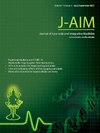系统性回顾和荟萃分析,重点关注阿育吠陀医学在脑瘫中的应用。
IF 1.7
Q3 INTEGRATIVE & COMPLEMENTARY MEDICINE
引用次数: 0
摘要
中西医结合疗法已被纳入姑息治疗,为患者提供全方位、多角度的护理。本研究旨在确定综合疗法的范围,特别是整体医疗系统,并证明其安全性和有效性,尤其是对脑瘫儿童的安全性和有效性。本研究使用特定术语搜索了主要数据库,包括 Embase、Cochrane、Medline/PubMed、Scopus、Google Scholar、Lilacs 和 Scielo。荟萃分析仅纳入随机和非随机临床试验。系统综述还包括病例对照、队列、横断面或回顾性观察研究。参与者包括接受脑瘫姑息治疗和阿育吠陀医学实践的 0-18 岁儿童。研究进行了描述性分析,包括年份、作者、设计、样本大小、干预和比较、结果和结论等数据。两项干预性研究比较了阿育吠陀疗法与其他疗法或物理疗法对脑瘫儿童的治疗效果。荟萃分析表明,使用阿育吠陀疗法的儿童痉挛情况有所改善。但是,在干预措施、对照组和评估结果的异质性方面存在局限性。包括阿育吠陀医学在内的综合疗法有可能改善生活质量、控制疾病症状并提供情感支持。然而,还需要更有力的证据来支持其广泛应用。使用阿育吠陀医学有证据表明可以改善脑瘫儿童的痉挛状况。注册编号:Prospero CRD 42020198399。本文章由计算机程序翻译,如有差异,请以英文原文为准。
A systematic review and meta-analysis focusing on the use of ayurvedic medicine in cerebral palsy
Integrative practices have been incorporated into palliative care to provide holistic and multidimensional care for patients.
This study aims to identify the scope of integrative practices, specifically whole medical systems, and demonstrate its safety and efficacy, specially in children with cerebral palsy.
Key databases, including Embase, Cochrane, Medline/PubMed, Scopus, Google Scholar, Lilacs and Scielo were searched using specific terms.
Only randomized and non-randomized clinical trials were included for meta-analysis purposes. Case-control, cohort, cross-sectional or retrospective observational studies were also included for the systematic review. Participants included children aged 0–18 years receiving palliative care for cerebral palsy and undergoing Ayurvedic Medicine practices.
Descriptive analysis was conducted, including data such as year; author; design; sample size; intervention and comparison; outcomes and conclusion.
Two interventional studies compared Ayurvedic practices with each other or with physiotherapy in children with cerebral palsy. The meta-analysis demonstrated an improvement in spasticity for children using Ayurvedic medicine. However, there were limitations in terms of heterogeneity in interventions, control groups, and assessed outcomes.
Integrative practices, including Ayurvedic medicine have the potential to improve quality of life, manage disease symptoms and provide emotional support. However, more robust evidence is needed to support their widespread use. The use of Ayurvedic medicine showed evidence of improvement in spasticity for children with cerebral palsy.
Registration number
Prospero CRD 42020198399.
求助全文
通过发布文献求助,成功后即可免费获取论文全文。
去求助
来源期刊

Journal of Ayurveda and Integrative Medicine
INTEGRATIVE & COMPLEMENTARY MEDICINE-
CiteScore
4.70
自引率
12.50%
发文量
136
审稿时长
30 weeks
 求助内容:
求助内容: 应助结果提醒方式:
应助结果提醒方式:


